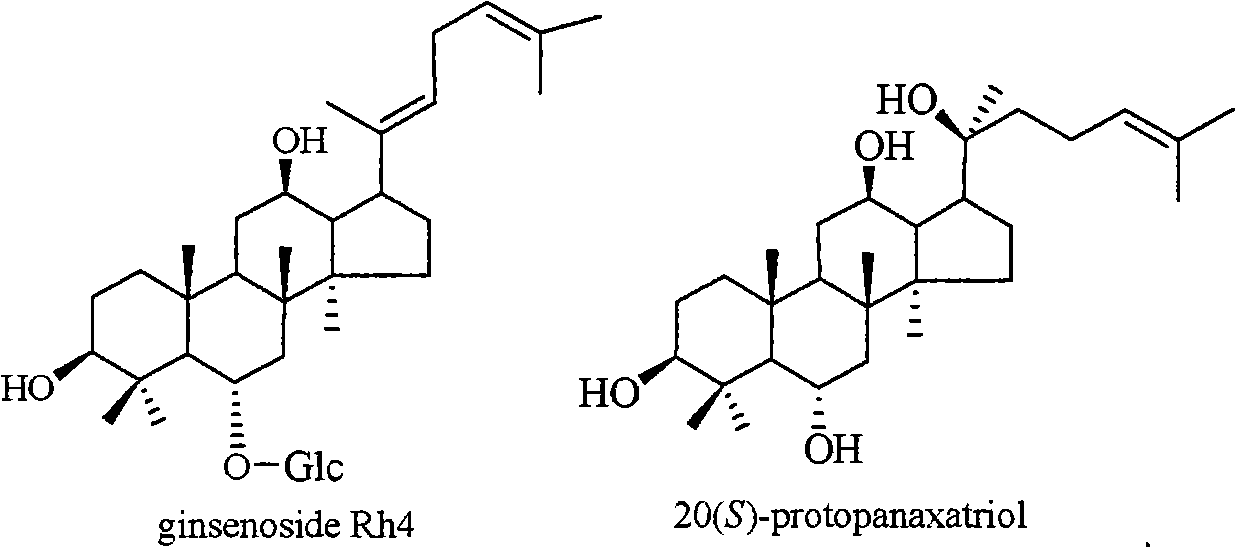Anti-coxsackie medicament composition and medicine use thereof
A coxsackie virus and anti-coxsackie technology, which can be applied in drug combinations, antiviral agents, medical preparations containing active ingredients, etc., can solve problems that have not been seen before
- Summary
- Abstract
- Description
- Claims
- Application Information
AI Technical Summary
Problems solved by technology
Method used
Image
Examples
Embodiment 1
[0026] Extraction, isolation and structural identification of two active compounds, ginsenoside Rh4 and 20(S)-protopanaxatriol:
[0027] 5kg Panax notoginseng was purchased in Yunnan, crushed into granules, wrapped with double gauze, placed in a pressure cooker, controlled at a high temperature of 120°C, and steamed for 12 hours to obtain cooked Panax notoginseng. The cooked notoginseng was reflux extracted with industrial ethanol (5L×4), and the solvent was recovered under reduced pressure and concentrated to obtain a total extract of 778g. Dissolve the extract in water, perform column chromatography with D101 macroporous adsorption resin (90×8.5 cm), first elute with water until the Molish reaction of the effluent is negative, and then elute with industrial methanol to obtain 440 g of crude saponin.
[0028] The crude saponin was mixed with about 500 g of silica gel (200-300 mesh), and subjected to dry column chromatography on silica gel (200-300 mesh), using chloroform-meth...
Embodiment 2
[0037] Toxicity determination test of ginsenoside Rh4(1) and 20(S)-protopanaxatriol on Hela cells:
[0038] After Hela cells were digested with trypsin, they were added to a 96-well culture plate, 100 μL / well. After the cells grew into a monolayer, the growth medium was discarded, and 100 μL of maintenance solution containing samples was added to each well. Four replicate wells were set for each dilution. Set normal cell control group, set 5% CO 2 Cultivate in an incubator at 37°C, observe the changes of cells every day, and calculate the maximum non-toxic concentration TC of the drug 0 .
[0039] Results The maximum non-toxic concentration TC of ginsenoside Rh4 and 20(S)-protopanaxatriol on Hela cells 0 50μg / mL, no obvious toxic effects.
Embodiment 3
[0041] Anti-CVB3 virus pharmacodynamic experiment of ginsenoside Rh4(1) and 20(S)-protopanaxatriol:
[0042] Hela cells were cultured in a 96-well plate to a monolayer, the growth medium was discarded, and the samples were diluted to six concentrations (within the maximum non-toxic range of the sample) with the maintenance solution, and 50 μL of the sample maintenance solution and virus dilution solution were added to each well, Set up 4 duplicate wells for each concentration, set up positive control group, virus control group and normal cell control group at the same time, set 5% CO 2 Cultivate in an incubator at 37°C, and observe the condition of cytopathic changes (CPE) every day. When the cytopathy of the virus control group reaches 75% and above and the normal cell control group is normal, observe and record the CPE of each well, use the MTT method to detect the inhibition rate of the sample to the virus, and calculate the half inhibitory concentration (IC) of the sample ...
PUM
 Login to View More
Login to View More Abstract
Description
Claims
Application Information
 Login to View More
Login to View More - R&D
- Intellectual Property
- Life Sciences
- Materials
- Tech Scout
- Unparalleled Data Quality
- Higher Quality Content
- 60% Fewer Hallucinations
Browse by: Latest US Patents, China's latest patents, Technical Efficacy Thesaurus, Application Domain, Technology Topic, Popular Technical Reports.
© 2025 PatSnap. All rights reserved.Legal|Privacy policy|Modern Slavery Act Transparency Statement|Sitemap|About US| Contact US: help@patsnap.com



